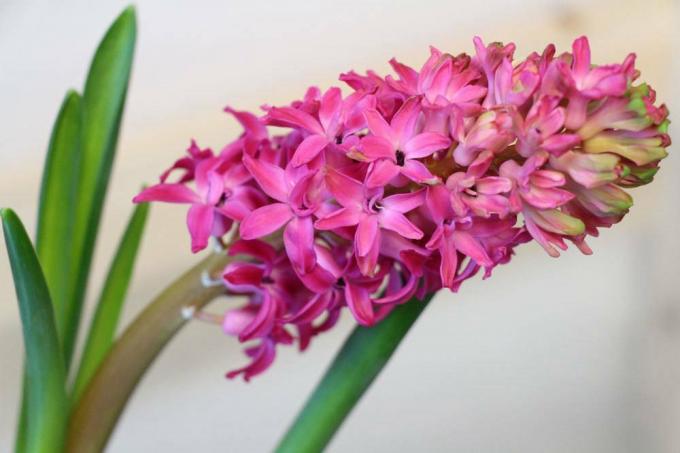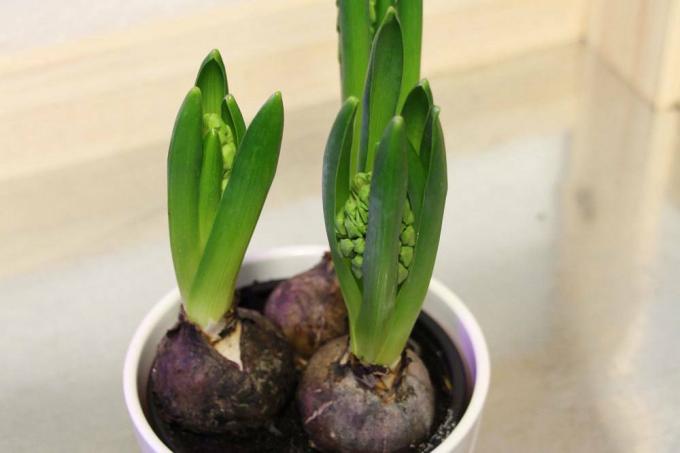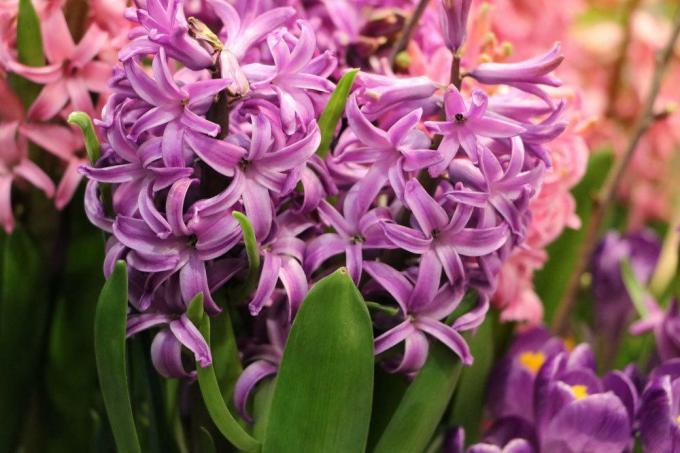
table of contents
- Toxicity
- For pets
- For the people
- Toxin
- Plant parts
- First aid
- When consumed
- Consequence
The hyacinth is a bulbous plant that reaches a height of up to 40 cm. The shiny green leaves are the origin of the inflorescence. Depending on the type of cultivation, the flowers are pink, red, blue or white in color. The tubular flowers give off a very pleasant, sweet smell. Originally, hyacinths come from the Mediterranean and Southwest Asia.
Toxicity
For pets
How dangerous is the plant for animals?
Hyacinths are poisonous for pets such as dogs, cats, rabbits and guinea pigs as well as for horses, sheep and goats. The ingredients of the plant irritate the mucous membrane and severe gastrointestinal discomfort can occur.
Typical symptoms of hyacinth poisoning are:
- profuse salivation and pain when swallowing
- watery diarrhea
- Nausea and vomiting (the latter does not occur in horses)
- Gastrointestinal pain, especially in horses, leads to severe colic

For the people
Hyacinth toxicity to humans
There are plant species that are only poisonous to animals. However, this does not apply to hyacinths, the plant is equally dangerous for humans and animals. This is also the reason why hyacinths are not used in naturopathy. At times, the onions of the plant were used as a treatment for jaundice, however were the side effects (hyacinth scabies) are too strong and so the plants are not used today more. In humans, too, the consumption of parts of plants mainly leads to symptoms of the gastrointestinal tract.
Typical symptoms are:
- Diarrhea and vomiting
- nausea
- severe abdominal pain
Toxin
How is hyacinth scabies created?
The hyacinth contains calcium oxalate, which has a strongly irritating effect on human skin. In nurseries, employees often report a scratch-like skin appearance when they deal with the plants frequently. This side effect is usually without consequences for an adult, but children should not be exposed to unprotected handling of the plant.

Plant parts
Which parts of the hyacinth are poisonous?
Hyacinths are classified as slightly toxic and that applies to all parts of the plant. The stem as well as the flowers and seeds contain irritants that can disturb the human and animal organism. The causes of toxic reactions vary, however, depending on the part of the plant consumed.
leaves
The leaves and flower stalks contain salicylic acid, which mainly affects the gastrointestinal area. However, if large amounts of these parts are consumed, kidney damage and respiratory paralysis can occur in an emergency. The lethal dose for animals is not yet known.
Onions
The onions contain calcium oxalate as a toxin, which also has its main effect on the gastrointestinal tract. At the same time, however, there are also skin symptoms that can be expressed in skin scabies. The main symptoms of consumption consist of vomiting, nausea and diarrhea.
Onions and seeds
Onions and seeds also contain saponins, which can also cause skin irritation. What initially begins as an itchiness manifests itself in severe cases as a bloody appearance of the skin with severe symptoms of inflammation. In this case, the treatment is carried out with cortisone in order to heal the inflammation.

First aid
When consumed
First aid when eating hyacinths
If a pet or a child has eaten parts of hyacinths, this is not a medical emergency, but should still be clarified by a doctor. As a first aid measure for children, giving large amounts of fluids has proven effective, but not milk. Water and tea are best. Medicinal charcoal is also given to relieve severe diarrhea and bind toxins.
In any case, it is advisable to call the poison control center, where further measures will be discussed. The affected animal should be presented to the veterinarian or the veterinary emergency service if the symptoms are severe. Children should also be brought into medical care, and the pediatrician should handle an emergency without an appointment. If the incident occurs outside of the general practice opening hours, a visit to the medical on-call service is usually sufficient. The emergency doctor is the best choice only if severe symptoms or impaired consciousness occur.
Consequence
Consequences of inadvertent consumption of the plant
As a rule, life-threatening reactions to the consumption of the plant are not to be expected. This is especially true when only small portions have been consumed. Symptoms usually last between 24 and 48 hours and then clear on their own. The administration of soothing medication is standard, especially for children and pets, since the abdominal symptoms are uncomfortable. How severe the symptoms are depends largely on the amount of plant parts consumed.
Sources:
https://www.botanikus.de/Botanik3/Ordnung/Hyazinthe/hyazinthe.html
http://gizbonn.de/156.0.html



